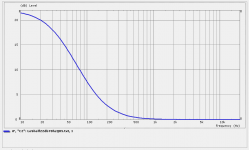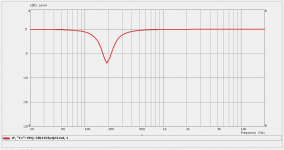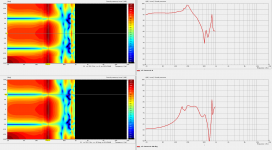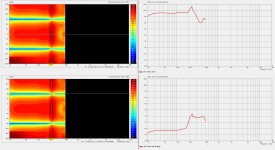I made simulation of H-frame (https://www.hifizine.com/files/2012/03/H-frame.png) and W-frame (https://www.hifizine.com/files/2012/03/Linkwitz-W-frame.png) in Akabak 3.
Both had frame depth 30+30 cm, double SB34NRX75-16 speakers in push-pull configuration, equalized in same way but results are significantly different.
Is W-frame force cancellation and smaller height better than H-frame higher response level, better on axis and polar plot responses?
In H-frame push-pull configuration distortions are partially compensated.
I presume in W-frame distortions are not compensated as much as there are different volumes (and air mass) on front and on back side of the speaker cones and speakers had direct pressure influence on each other.
What you prefer to build?
Or better is something in between like M-frame push-pull: https://www.hifizine.com/files/2012/12/M-frame-pp.png
Images are: 1. Low shelf bass compensation, 2. Dipole peak EQ, 3. H-frame on axis and 90 degree responses and full polar plot (Akabak had some bug in polar plot in -150 - -180 region) 4. same for W-frame.
Both had frame depth 30+30 cm, double SB34NRX75-16 speakers in push-pull configuration, equalized in same way but results are significantly different.
Is W-frame force cancellation and smaller height better than H-frame higher response level, better on axis and polar plot responses?
In H-frame push-pull configuration distortions are partially compensated.
I presume in W-frame distortions are not compensated as much as there are different volumes (and air mass) on front and on back side of the speaker cones and speakers had direct pressure influence on each other.
What you prefer to build?
Or better is something in between like M-frame push-pull: https://www.hifizine.com/files/2012/12/M-frame-pp.png
Images are: 1. Low shelf bass compensation, 2. Dipole peak EQ, 3. H-frame on axis and 90 degree responses and full polar plot (Akabak had some bug in polar plot in -150 - -180 region) 4. same for W-frame.
Attachments
Here is M-frame, exactly same outside measurements as W-frame, speakers are on baffles with 90 degree angle, height is 66 cm. H-frame had height of 82 cm as speakers did not fit to smaller size.
Seems like different dipole peak shape can be caused by different cavity size.
But still question remains, how important is force cancellation and front-rear cavity symmetry for distortion cancellation?
For M-frame version is also not possible to get front-rear cavity symmetry as is possible for H-frame.
With simulations I noticed that for good polar plot is essential to place speakers precisely in the middle of frame. Even small inaccuracy give significantly not symmetrical rear/front patterns.
Seems like different dipole peak shape can be caused by different cavity size.
But still question remains, how important is force cancellation and front-rear cavity symmetry for distortion cancellation?
For M-frame version is also not possible to get front-rear cavity symmetry as is possible for H-frame.
With simulations I noticed that for good polar plot is essential to place speakers precisely in the middle of frame. Even small inaccuracy give significantly not symmetrical rear/front patterns.
Attachments
Last edited:
Very interesting sims. First to answer your questions:
M- or W-frame will not have very good vibration cancellation. Even order harmonic cancellation will only be approximate due to a variety of factors.
Both H-and M/W frame will have close to the same front and rear responses. This depends somewhat on the driver frame/magnet and how much larger the frame is compared to the driver.
I like to build large H-frames. By large I mean both with a large D (front to back distance) and a large mouth opening. My latest measures about D=1m and the mouth is about 0.6mx0.6m. It's size is like a modest table, and I locate it between the speakers and use it as the stand for a heavy multichannel amplifier, on top of a slab of granite. The added weight helps to anchor the unit and acts against vibration. The reason to choose this size is that the front and back tunnels form resonances (as your sims show) and the Q of these is dependent on the aspect ratio of the tunnel (width to depth ratio). A long, narrow tunnel will have a high Q resonance. In contrast as you made the tunnel wider/shallower the Q goes down. A ratio where the mouth width is about 0.5*D gives a relatively low Q that allows you to incorporate the resonance peak into the passband to some degree. This helps to extend the passband upwards as much as possible while at the same time minimizing dipole losses at low frequency. I choose D and then set the mouth opening following the rule I mentioned above. You can put any size driver into this H-frame as long as it will fit inside.
Getting back to your sims, I think these are interesting because they show the 90 degree response coming up near the resonance peak (above 100Hz) much more than I expected. This corresponds to what I have "heard" with my own H-frame as well as with Linkwitz's LS521 M-frame: they can be very "warm" in the midbass. Because you hear the power response of the bass for a dipole, if the 90 deg response comes up so will the power response compared to below the resonant peak. For the H-frame your sims show this rise to be about 6dB, and some EQ would need to be employed to reduce the power to that region to eliminate the coloration.
M- or W-frame will not have very good vibration cancellation. Even order harmonic cancellation will only be approximate due to a variety of factors.
Both H-and M/W frame will have close to the same front and rear responses. This depends somewhat on the driver frame/magnet and how much larger the frame is compared to the driver.
I like to build large H-frames. By large I mean both with a large D (front to back distance) and a large mouth opening. My latest measures about D=1m and the mouth is about 0.6mx0.6m. It's size is like a modest table, and I locate it between the speakers and use it as the stand for a heavy multichannel amplifier, on top of a slab of granite. The added weight helps to anchor the unit and acts against vibration. The reason to choose this size is that the front and back tunnels form resonances (as your sims show) and the Q of these is dependent on the aspect ratio of the tunnel (width to depth ratio). A long, narrow tunnel will have a high Q resonance. In contrast as you made the tunnel wider/shallower the Q goes down. A ratio where the mouth width is about 0.5*D gives a relatively low Q that allows you to incorporate the resonance peak into the passband to some degree. This helps to extend the passband upwards as much as possible while at the same time minimizing dipole losses at low frequency. I choose D and then set the mouth opening following the rule I mentioned above. You can put any size driver into this H-frame as long as it will fit inside.
Getting back to your sims, I think these are interesting because they show the 90 degree response coming up near the resonance peak (above 100Hz) much more than I expected. This corresponds to what I have "heard" with my own H-frame as well as with Linkwitz's LS521 M-frame: they can be very "warm" in the midbass. Because you hear the power response of the bass for a dipole, if the 90 deg response comes up so will the power response compared to below the resonant peak. For the H-frame your sims show this rise to be about 6dB, and some EQ would need to be employed to reduce the power to that region to eliminate the coloration.
But still question remains, how important is force cancellation and front-rear cavity symmetry for distortion cancellation?
Force cancellation is a useful property due to the large excursions you might want. The W-frame is very effective the M-frame, not so much, IIRC I read somewhere ~0.7 times as effective, you could work it out using vectors.
What factors you mean?Even order harmonic cancellation will only be approximate due to a variety of factors.
Is even harmonic cancellation with push-pull speaker alignment better in H-frame than on W and M?
Must be volumes symmetrical not only in size but also in shape on both sides of speaker cone?
What kind of volumes need to be left on W- and M-frame to get best harmonic cancellation?
Last edited:
What factors you mean?
Is even harmonic cancellation with push-pull speaker alignment better in H-frame than on W and M?
Must be volumes symmetrical not only in size but also in shape on both sides of speaker cone?
What kind of volumes need to be left on W- and M-frame to get best harmonic cancellation?
The idea is to combine the output from the front of the cone, and the back of another cone, to cause even order products to cancel. You can get somewhere from 10dB to 20dB of cancellation, but its never perfect. It's still better than no cancellation! The front and rear just are not producing 100% the same output. For example, the motor and basket influence the rear response. The volume/size/dimension of the system are probably not going to matter all that much. There is no cancellation for an H-frame, if it only uses 1 driver. You could use a 2x2 (four drivers) setup to get cancellation. That would work nicely in a large H-frame, using e.g. four 10" or 12" drivers.
Last edited:
The mathematics behind of forces is clear, but how in practical life? If I not need more than 95 dB SPL level at 1m, will H-frame shake and reproduce unwanted noise and W-frame is dead silent?Force cancellation is a useful property due to the large excursions you might want. The W-frame is very effective the M-frame, not so much, IIRC I read somewhere ~0.7 times as effective, you could work it out using vectors.
Has anyone measured the distortion or reviewed the SB34NRX75-16 woofers yet? I didn't see any distortion reduction methods such as shorting rings in the manufacturers data but other specs look nice.
I built a W-frame with drivers back to back, the magnets tightly coupled and I couldn't feel any vibration or movement from the cabinet. I made a U-frame with two drivers in a very well braced cabinet and at low frequency and high excursion it twisted until I put sorbothane feet under it 🙂The mathematics behind of forces is clear, but how in practical life? If I not need more than 95 dB SPL level at 1m, will H-frame shake and reproduce unwanted noise and W-frame is dead silent?
I had U-frame with one 18", total weight about 40 kg, speakers Mms is 130 g, I had not noticed any cabinet vibration.
Two SB34NRX75-16 will have summed Mms 144 g., total planned weight will be over 45 kg.
Two SB34NRX75-16 will have summed Mms 144 g., total planned weight will be over 45 kg.
Last edited:
I also had not find any measurements, my built is still in design phase. I had not yet ordered SB34NRX75-16 as my be they are not the best option.Has anyone measured the distortion or reviewed the SB34NRX75-16 woofers yet? I didn't see any distortion reduction methods such as shorting rings in the manufacturers data but other specs look nice.
- Home
- Loudspeakers
- Multi-Way
- H-frame or W-frame OB bass?




